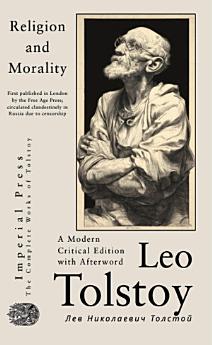Religion and Morality
O ovoj e-knjizi
Tolstoy drafted Religion and Morality (Религия и нравственность, sometimes titled О религии и нравственности) at Yasnaya Polyana in the autumn of 1893. Diary entries show that on 30 October 1893 he told Vladimir Chertkov he had “finished, it seems, the religion piece,” after weeks of revising a reply to two questions sent him about the meaning of religion and the independence of morality . The essay belongs to the late publicist phase that followed his spiritual crisis of the 1880s and was written side-by-side with “Christianity and Patriotism” and other anti-state tracts. In it he relies on decades of daily Gospel study—especially the Sermon on the Mount, which he copied out and commented on repeatedly in his notebooks.
Because the Russian censors would not pass the text, Tolstoy let his London-based supporter Vladimir Tchertkoff publish it abroad. An English translation appeared in the Free Age Press pamphlet series Pamphlets. Translated from the Russian (Christchurch, 1900), bundled with “Patriotism and Government” and other tracts. Underground hectograph copies of the Russian manuscript circulated until the first legal Russian edition was issued in St Petersburg in 1906 by the radical imprint “Obnovlenie”; the publisher, H. E. Felten, was promptly charged under press-laws for disseminating Tolstoy's banned works.
The essay argues that “religion” is each person’s felt relationship to the infinite and that any genuine morality grows from that relationship; to divorce the two is impossible. Tolstoy attacks Auguste Comte’s positivism for reducing faith to a sociological tool and brands Arthur Schopenhauer’s pessimism another philosophy of self-interest. By contrast, he grounds his own position in the ethics of the Gospels, insisting that only service to the divine will—expressed as universal compassion and non-violence—can give life meaning and guide conduct.
This critical reader's edition presents a modern translation of the original manuscript, crafted for the modern reader with clean, contemporary language and simplified sentence structures that clarify his complex Russian phrasing and specific antiquated references. Supplementary material enriches the text with autobiographical, historical, and linguistic context, including an afterword by the translator on Tolstoy’s personal history, impact, and intellectual legacy, an index of the philosophical concepts he employs—emphasizing Existentialism and influence by Schopenhauer—a comprehensive chronological list of his published writings, and a detailed timeline of his life, highlighting the personal relationships that shaped his philosophy.











